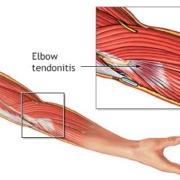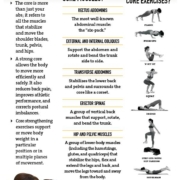7 Essential Posture Hacks for Better Spinal Alignment
In an age where we find ourselves hunched over screens and slouched in chairs for hours on end, the importance of good posture often takes a backseat. However, maintaining proper spinal alignment is crucial not just for our physical health, but also for our overall well-being. If you’re looking to enhance your posture and relieve discomfort, you’re in the right place! In this listicle, we’ll explore 7 essential posture hacks that can transform the way you sit, stand, and move throughout your day. From simple adjustments to mindful practices, these tips will empower you to take control of your spinal health, improve your energy levels, and boost your confidence. Get ready to unlock the secrets to a more aligned and balanced you!
1) Mind Your Head: Keep your head aligned with your spine to avoid unnecessary strain. Imagine a string gently pulling the top of your head towards the ceiling, helping you maintain an upright posture throughout your daily activities
To maintain a posture that supports spinal alignment, envision a delicate string extending from the crown of your head, gently tugging you upward. This mental image serves as a reminder to keep your head in line with your spine, preventing unnecessary strain on your neck and back. When standing or sitting, consciously adjust your position to ensure that your ears are aligned with your shoulders, and your shoulders are stacked over your hips. This alignment not only promotes better posture but also enhances your overall body mechanics, allowing for smoother movement throughout your day.
Incorporating this concept into your daily routine can be simple and effective. Here are a few tips to help you stay aligned:
- Adjust Your Workspace: Ensure your computer screen is at eye level to avoid tilting your head down or craning your neck.
- Mindful Movement: When walking or exercising, keep your chin parallel to the ground, allowing your head to float naturally atop your spine.
- Regular Breaks: Take short breaks to reset your posture, especially during prolonged periods of sitting.
2) Sit Smart: Invest in a chair that supports your lower back, encouraging a natural curve in your spine. Position your feet flat on the floor, and use a cushion or lumbar roll if needed to help keep your back straight and your hips aligned
Choosing the right chair is crucial for maintaining proper spinal alignment, especially if you spend long hours sitting. A chair that supports your lower back will promote a natural curve in your spine, significantly reducing the risk of discomfort and long-term issues. Look for chairs that offer adjustable lumbar support, allowing you to customize the fit according to your body shape. Ensure that your feet rest flat on the floor; if they don’t, consider using a footrest to achieve the ideal position. This alignment not only enhances comfort but also encourages better blood circulation, keeping you energized throughout the day.
In addition to investing in a quality chair, you can enhance your seating experience by incorporating a few simple accessories. A cushion or lumbar roll can provide extra support, filling the gap between your lower back and the chair. This helps maintain a straight back and aligns your hips properly. Here are some additional tips to optimize your sitting posture:
- Adjust your chair height so your knees are at a 90-degree angle.
- Keep your elbows close to your body and at desk level.
- Take regular breaks to stand, stretch, and walk around.
3) Stand Tall: When standing, distribute your weight evenly on both feet and keep your shoulders relaxed and back. Engage your core muscles slightly to support your spine, and try to avoid locking your knees for better stability and alignment
When you stand, it’s crucial to distribute your weight evenly across both feet to maintain balance and support your spine. This means aligning your feet hip-width apart, which helps create a stable foundation. Relax your shoulders and pull them back gently to open up your chest, allowing for better breathing and circulation. Engaging your core muscles slightly not only provides stability but also helps protect your lower back from strain. Remember, a relaxed stance is key; you want to feel grounded without being rigid.
Avoid locking your knees, as this can lead to tension and discomfort. Instead, keep a slight bend in your knees to enhance your overall posture. This small adjustment can significantly improve your alignment and reduce the risk of injury. Here are a few quick tips to enhance your standing posture:
- Foot Position: Keep your feet flat on the ground.
- Core Engagement: Gently activate your abdominal muscles.
- Knee Flexibility: Maintain a slight bend in your knees.
4) Screen Savvy: Position your computer screen at eye level to reduce neck strain. This encourages you to maintain a neutral head position, preventing the common tech neck posture that can lead to discomfort over time
To achieve optimal spinal alignment while working at your computer, it’s crucial to ensure that your screen is positioned at eye level. This simple adjustment can make a world of difference in how you feel throughout your day. When your screen is too low or too high, it forces your neck into awkward angles, leading to what many refer to as “tech neck.” By elevating your monitor, you encourage a more natural and neutral head position, allowing your spine to align properly and reducing the risk of discomfort and strain.
Consider the following tips for setting up your workstation:
- Use a monitor stand: This can help lift your screen to the ideal height.
- Adjust your chair: Ensure your chair supports your back while allowing your feet to rest flat on the ground.
- Keep your eyes level: The top of your screen should be at or slightly below eye level.
- Take breaks: Regularly step away from your screen to stretch and reset your posture.
By implementing these adjustments, you can create a workspace that not only enhances your productivity but also promotes better spinal health. Maintaining a neutral head position will not only help you feel more comfortable but will also contribute to long-term wellness, allowing you to work efficiently without the nagging discomfort that often accompanies poor posture.
5) Stretch It Out: Incorporate regular stretching into your routine to maintain flexibility and relieve tension in your muscles. Focus on stretches that target the chest, shoulders, and hip flexors, as they play a crucial role in supporting proper spinal alignment
Incorporating regular stretching into your routine is essential for maintaining flexibility and alleviating muscle tension, especially in key areas that influence your spinal alignment. By focusing on stretches that target the chest, shoulders, and hip flexors, you can significantly enhance your posture and overall well-being. Here are some effective stretches to include in your daily regimen:
- Chest Opener: Stand tall and clasp your hands behind your back, gently pulling your shoulders back and down. Hold for 20-30 seconds.
- Shoulder Stretch: Cross one arm across your body and use the opposite hand to gently pull it closer to your chest. Hold for 15-20 seconds on each side.
- Hip Flexor Stretch: Kneel on one knee with the other foot in front, creating a 90-degree angle. Push your hips forward to feel a stretch in the hip flexor of the kneeling leg. Hold for 20-30 seconds on each side.
To help you remember these stretches, consider creating a simple weekly stretching schedule. Below is a sample table to guide you:
| Day | Stretch Focus |
|---|---|
| Monday | Chest Opener |
| Tuesday | Shoulder Stretch |
| Wednesday | Hip Flexor Stretch |
| Thursday | Chest Opener |
| Friday | Shoulder Stretch |
| Saturday | Hip Flexor Stretch |
| Sunday | Rest & Recovery |
The Way Forward
As we wrap up our exploration of these seven essential posture hacks, remember that maintaining proper spinal alignment is not just about looking good—it’s about feeling good too. By incorporating these simple adjustments into your daily routine, you can enhance your overall well-being and prevent discomfort in the long run. Whether you’re at your desk, on the go, or winding down at home, these strategies are designed to seamlessly fit into your lifestyle.
So, take a moment to reflect on your posture right now. Are you sitting up straight? Are your shoulders relaxed? Small changes can lead to significant improvements, and your spine will thank you for it. Embrace these hacks, share them with friends and family, and embark on a journey toward a healthier, more aligned you. After all, a strong foundation supports everything else in life—so let’s stand tall together!









Leave a Reply
Want to join the discussion?Feel free to contribute!